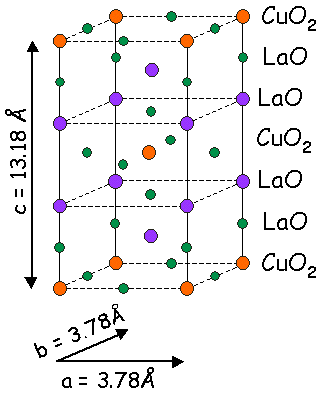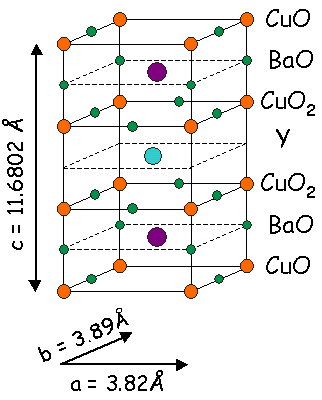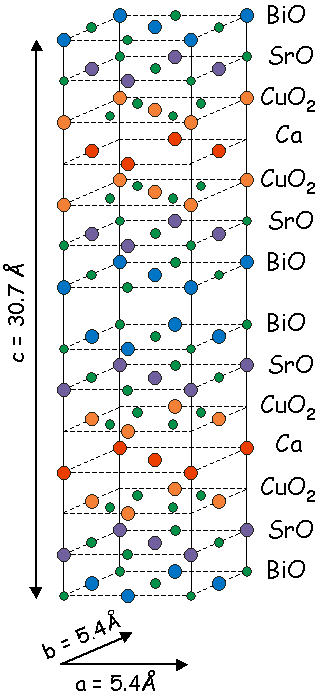Superconducting Cuprates
There are three main families of hole-doped cuprate high temperature superconductors studied today. However, much of the confusion in the study of HTSC results from the fact that each material is accessible to different experimental techniques. For example, it is easy to measure the electronic density of states of Bi2Sr2CaCu2O8+x, but harder to measure its magnetic properties. In the quest to find a unifying theory for all HTSC, it is tempting to treat these three as one material, and combine the experimental results from all families. Because of this common practice, the field of high-Tc research is rife with conflict and apparent contradictions.
A good summary of the zoology of many of the known hole-doped HTSC materials along with an explanation of the variation in their Tc's is given by Eisaki et al.
La2-xSrxCuO2
|
The lanthanum family of high-Tc's was the first family of materials to be discovered, by Bednorz and Muller in 1986. The structure of LSCO is shown to the right (with no Sr content). LSCO is physically the hardest of the three materials, and with stronger bonds it is easier to grow large (> 1 cm!) single crystals. Neutron scattering experiments, which probe the magnetic structure of the material, are typically limited to studying LSCO because of their requirement for large single crystals. But LSCO has not been successfully studied with an STM, because so far there has been no successful recipe to obtain an atomically flat surface with tunnel access through an insulating layer to the relevant unperturbed CuO2 plane. |
 |
YBa2Cu3O7-x
 |
The discovery of YBCO followed that of LSCO within a year. YBCO was the first material to break the 77 K (liquid nitrogen) temperature boundary. The optimal Tc is now >90 K. The structure of YBCO is shown to the left. YBCO has perhaps been the most highly studied because it is the cleanest and most ordered crystal. But studies of YBCO can also be quite confusing because there are two CuO planes: the square plane and the chain plane. By analogy with the other HTSC families, it is thought that the superconductivity originates in the square plane, but it is hard to isolate the behaviors of the planes. YBCO is not an ideal material for STM studies, because it typically cleaves on the chain plane. STM studies of the chain planes have been made by Derro et al, but this is not usually thought to access the intrinsic superconducting properties of the material. YBCO has typically been used in nuclear magnetic resonance (NMR) studies, which probe the spatial distribution of magnetic field. This is because YBCO is so well ordered that all atoms of a particular species will live in the same electronic environment (not true for BSCCO or LSCO). More recently, very clean YBCO has been used for quantum oscillation experiments, to map out the size of the Fermi pockets. |
Bi2Sr2CaCu2O8+x
|
Finally we come to BSCCO, the favorite material for STM and ARPES. BSCCO was discovered in 1988. BSCCO itself can have 1, 2, or 3 CuO planes, with Tc increasing with the number of planes. Bismuth can also be replaced with thallium or mercury, which results in the highest Tc material known (~135K). BSCCO competes with YBCO as the most technologically useful material. YBCO has been used in magnetic field applications because it is easier to pin flux. YBCO can be used to grow high-Tc SQUIDS with grain-boundary Josephson junctions. Their higher operating temperature makes it easier to study living biological materials. BSCCO has been formed into superconducting wires (with silver) and placed into the Detroit power grid but problems in maintaining vacuum have delayed the success of this operation. The structure of BSCCO is shown to the right. Surface sensitive techniques such as STM and ARPES can study BSCCO because it cleaves easily between layers, leaving an atomically flat surface for study, and, it is thought, direct tunnel access to the relevant unperturbed CuO2 plane. |

|